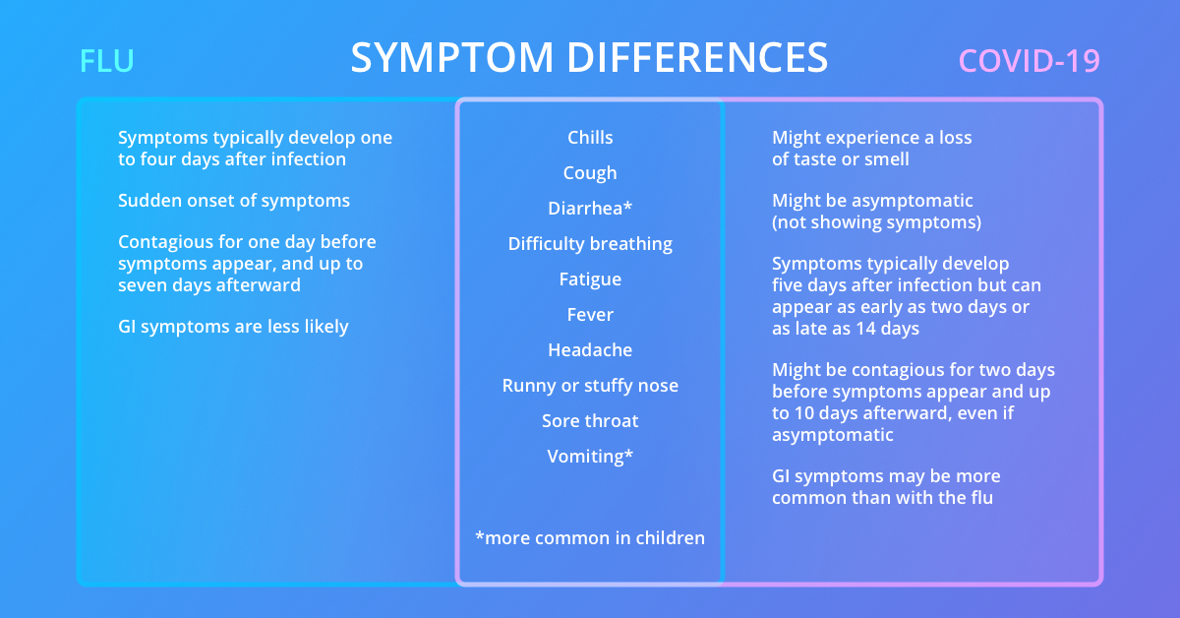COVID-19 or the Flu? Here Are the Differences
[Image description: A woman is looking at her smartphone and having a telehealth visit as she sits on a couch.]
As we enter fall, you and your family may have concerns about the flu (influenza) and how its symptoms differ from those of COVID-19. Even though both conditions are contagious respiratory (lung and breathing) illnesses and share many of the same symptoms, they are caused by two different viruses. Here are some ways to identify and prevent the flu and COVID-19.
COVID-19 or the flu?

[Image description: The image is of a chart with a Venn diagram comparing the flu and COVID-19 symptoms. Both conditions have symptoms that may include chills, cough, diarrhea, difficulty breathing, fatigue, fever, headache, runny or stuffy nose, sore throat, and vomiting.]
Because the symptoms for both conditions have many similarities, testing may be necessary to determine whether you have COVID-19 or the flu. Remember, you can turn to telehealth as your first line of defense. Talk to a doctor on Amwell anytime for advice and next steps for care.
The main questions to keep in mind, and that your doctor may ask you, are:
- Do you have a fever?
- Are you experiencing a loss of taste or smell?
- Do you feel short of breath or have difficulty breathing?
- Did your symptoms come on quickly?
- Have you been in contact with someone who has a confirmed case of COVID-19?
Testing
You may be wondering if it’s possible to have both COVID-19 and the flu. While the answer is yes, health experts are still studying how common it is. The CDC has developed a test that can check for both COVID-19 and the flu at once, which is available at certain public health testing locations. COVID-19 testing is readily available at many healthcare locations. Check your state or local health department’s website for the latest information.
Protect yourself against COVID-19 and the flu
You and your family can take preventive steps for these illnesses.
- Get a flu shot. While there is no vaccine for COVID-19 yet, there is one for the flu. The CDC recommends that most people six months and older get a flu shot. The flu shot is essential this year, not only to protect yourself against the flu but also to preserve healthcare resources.
- Wear a mask. Cover your mouth and nose with a mask when you’re in public or around people you don’t live with. This can help prevent the spread of COVID-19.
- Wash your hands often. Use soap and water for at least 20 seconds or, if not available, a hand sanitizer with at least 60% alcohol.
- Stay six feet away from others. Keep in mind that masks are not a substitute for physical distancing. Maintaining this distance will help reduce the likelihood of people spreading viruses, especially when speaking, laughing, or even just breathing.
- Cover your coughs and sneezes. Use a tissue or the inside of your elbow when you cough or sneeze to protect those around you.
- Clean and disinfect frequently touched surfaces daily. This may include phones, tablets, tables and countertops, light switches, doorknobs, keyboards, remote controls, sinks, faucets, and toilets.
What to do if you have symptoms
It’s important to be prepared if you do start to feel sick. Here are some tips to keep in mind:
- Stay home when you aren’t seeking in-person medical care. Most people with the flu or COVID-19 have mild symptoms and can recover at home. Usually, rest, hydration, over-the-counter medications such as acetaminophen (Tylenol), and antiviral medications for the flu can be very effective.
- Separate yourself from others in your home. If possible, stay in another room or use a different bathroom.
- Be sure to get care if you have trouble breathing or have an emergency. Call ahead before visiting the provider so they know to expect you.
- If you need to talk to a doctor or get next steps for care for non-emergency symptoms, you can have a visit on Amwell 24/7.
- Track your symptoms daily and stay in touch with your healthcare provider or primary care physician.
- Check your symptoms against the CDC's list of Symptoms for COVID-19.
Help keep your community safe this flu season by taking preventive steps and staying home if you are sick. Remember, you can find support for COVID-19, the flu, and any other non-emergency medical concerns by having a telehealth visit from home.